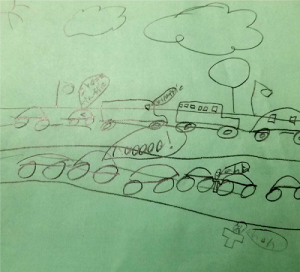After a school completed their surveys, and walking and biking audit, the next step is to start the action planning process. The action planning process is intended to engage community, and this case study on Mill Elementary school in Dearborn shows how they fostered community engagement to create their action plan.
As the birthplace of Henry Ford, it is no surprise that transportation planning in Dearborn was designed around the automobile. With this backdrop, the safety issues become evident when assessing pedestrian and transportation safety, especially around Miller Elementary School. When talking about the experience of traveling to Miller, PTA board member and parent, Habib Abbas expressed that it “feels dangerous while driving, not to mention walking. The issues and concerns from parents have made safety improvements a big goal for our community.”
Since 2016, Principal Radewin Awada has focused on identifying safety improvements for Miller Elementary. Awada assembled a team to search for opportunities to improve student transportation safety and came upon Michigan Fitness Foundation’s Safe Routes to School program.

Determined to move forward, they began the Safe Routes to School (SRTS) action planning process. Through this, they emphasized parent and community involvement to better understand critical infrastructure needs around the school as well as the funding necessary to make the improvements. The team’s approach focused on:
- Being mindful of the time of all involved
- Ensuring messages resonated with project goals, and
- Considerations of outreach communications methods communication considerations.
By recognizing the value of everyone’s time, they were able to determine how to best schedule the action planning meeting. As a result, they scheduled meetings to coincide when parents were likely to be at the school and ensured they didn’t exceed their scheduled dismissal time so parents would manage the other needs of their families. Their communication methods included timely reminders the week before, day prior and day of the action plan event using the school’s group text and call system. In addition to being mindful of their time and providing a robust communications plan, they also provided food to nourish and show appreciation for everyone’s participation in the meetings.
The messages sent centered on the importance of and opportunity for parent involvement to inform future action priorities. They provided background context for newcomers to the school community who might be unaware about existing efforts to address safety issues. They also framed the issues as part of larger health efforts already embedded and initiated at the school.
Because Dearborn is home to one of the largest proportions of Arab Americans in the United States, the team brought in a translator to ensure the action plan meeting was an event where all parents could participate. Offering bilingual messages with the support of a translator on site made it possible for all parents to participate in the conversation, which was vital to the overall success of the planning process.

While the team engaged parents in the planning process, incorporating student perspectives was also an important part of the work. Teachers assisted by capturing student experiences and challenges getting to school through illustrations. These illustrations showed the students’ knowledge of safe pedestrian behaviors, such as looking both ways, but they also highlighted how these skills when used in the current build environment around the school have limited effect in providing students the opportunity to walk to school and feel safe.
Looking at the planning process through Miller Elementary’s approach illustrates how engagement strategies are successful when the needs of the community are recognized and respected. Encouraging stakeholders to be empowered as active participants often requires a variety of approaches.
Before engaging the community, it is important to understand and identify engagement techniques – whether it’s with visual storytelling, using interpreters, text messaging, or interactive polling with group discussions. Drawing on the strengths of those participating and acknowledging the quality of a group’s contributions to the process will help to achieve the best outcomes.
